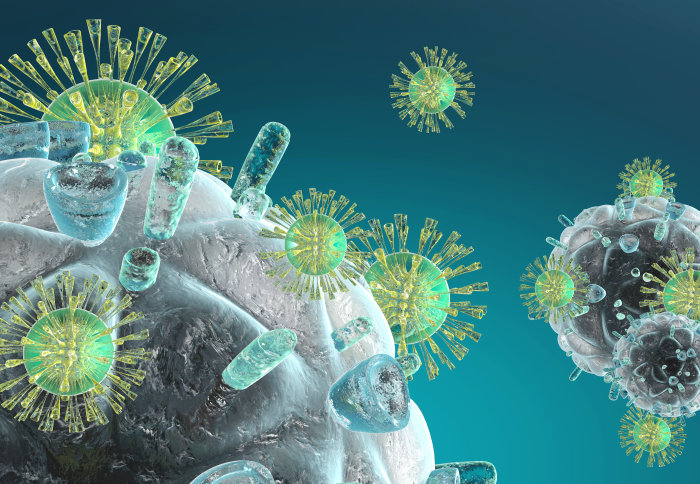Killer immune cells fend off viruses with a helping hand from key proteins

New research reveals how killer cell immunoglobin-like receptors (KIRs) can strengthen the immune system’s response to HIV-1, HCV and HTLV-1 infection
The study, published last week in Science Immunology, demonstrates for the first time how KIRs – tiny cell-surface proteins that help to regulate how our killer immune cells fight off infections – can significantly influence clinical outcomes in human immunodeficiency virus (HIV-1), hepatitis C virus (HCV), and human T cell leukaemia virus (HTLV-1) infection. Building on previous research conducted in mice, the Imperial team combined experimental immunology and mathematical modelling to determine the role of KIRs within the human immune system.
Making sense of the middleman
To investigate whether inhibitory KIRs (iKIRs) have a clinically significant impact on killer immune cell response, the researchers behind the study set about to investigate possible links between iKIRs and a family of genes known as human leukocyte antigens, or HLAs. HLAs are responsible for helping the immune system to distinguish foreign invaders such as viruses and bacteria, and genetic variants (alleles) within the HLA family play a key role in determining an individual’s susceptibility to certain viruses, such as HIV. The study team hypothesised that if KIRs significantly impacted on killer immune cell response, then they would also have an impact upon HLA disease associations.
Firstly, the team studied a cohort in the early stages of HIV infection, and found that the genetic variant HLA-B57 provided greater immune protection in the presence of KIR genes. Upon further investigation, the researchers found that this protective boost was dependent on the presence of KIR ligands – important molecules that bind to receptors and establish signalling pathways that activate key immune responses. They also found that that a strong inhibitory signal ensured that the protective effect of HLA-B57 could be sustained over time; with a weaker signal, the effect was lost.
In addition, the team also investigated how iKIRs influenced the detrimental association between genetic variant HLA-B35Px and clinical outcomes of HIV-1 infection, and found that the harmful impact of the variant was also boosted by the presence of functional iKIRs. After studying three independent cohorts, the researchers concluded that the effects of both protective and detrimental HLA genetic variants on viral load and disease progression in HIV-1, HCV and HTLV-1 were enhanced by functional iKIRs.
Clarifying contradictions
To determine how iKIRs boost can boost both protective and detrimental effects of HLA associations by enhancing killer immune cell survival, the team developed a mathematical model of host-virus dynamics for HIV-1. By generating thousands of random simulations of the virus in action, the researchers confirmed that both protective and detrimental HLA effects were enhanced simultaneously.
We think this is a great example of how interdisciplinary research overcomes a major hurdle in immunology and gives a unique insight into the human immune system Dr Becca Asquith Senior author
In investigating how both beneficial and harmful alleles could be boosted at the same time, the team saw that when the lifespan of killer immune cells was short, an individual’s allele type made little difference to disease progression and clinical outcome. Conversely, when the lifespan of killer immune cells increased (owing to the presence of a high number of iKIRs), there was a significant difference in viral load between individuals with average, protective or detrimental HLA alleles. This suggests that as iKIRs enhance the lifespan of killer immune cells, the effects of an individual HLA alleles on disease progression – whether good or bad – will also be heightened.
Next steps
By illustrating the crucial role of KIRs, the findings of the study suggest that these molecules could be targeted with drugs as a means of controlling an individual’s immune responses to different kinds of viruses. The team behind the study are now looking to build on their findings by using tracer dyes to track cell division, allowing them to directly measure immune cell survival in the human body.
Senior author Dr Becca Asquith, Reader in Mathematical Immunology at Imperial’s Department of Medicine, commented: “We think this is a great example of how interdisciplinary research (in this case, combining mathematics with traditional experimental immunology) overcomes a major hurdle in immunology and gives a unique insight into the human immune system.”
‘Inhibitory killer cell immunoglobulin-like receptors strengthen CD8+ T cell–mediated control of HIV-1, HCV, and HTLV-1’ by Lies Boelen et al. is published in Science Immunology
Image credit: Shutterstock
Article supporters
Article text (excluding photos or graphics) © Imperial College London.
Photos and graphics subject to third party copyright used with permission or © Imperial College London.
Reporter
Ms Genevieve Timmins
Academic Services